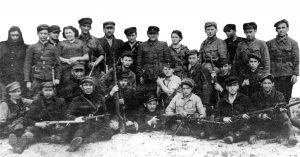Courage & Compassion: The Legacy of the Bielski Brothers

An original, award-winning The FHM exhibition, Courage and Compassion: The Legacy of the Bielski Brothers chronicles the Bielski brothers’ story. This exhibition, presented nationally by Bank of America, is a multi-media presentation showcasing the heroic efforts of three brothers who helped save more than 1,200 people while living in the forest during World War II.
Three brothers, Tuvia, Asael and Zus Bielski, took refuge from the Nazis in the forests surrounding Novogrudok, Belarus. In the forest, they formed a community of men, women and children that numbered more than 1,200 by the end of the war. The brothers led the group in acts of sabotage and defense against the Nazis. It is through the brothers’ leadership that the group survived starvation, harsh winters and the threat of the Nazis and their collaborators.
During World War II, three of the Bielski brothers ran a Jewish partisan unit in Western Belorussia that saved close to 1,200 Jews from the ghettos of Novogrudok and Lida and the surrounding countryside. Their unit or otriad, as known in Russian, was unique. While the great majority of partisan groups in World War II sought to fight the Germans in their midst, the Bielski brothers cared more about preserving the lives of as many Jews as possible than they did about attacking the German forces that occupied Western Belorussia. For more than two years the brothers commanded their partisan unit in the Belorussian forests. Their acts of rescue during extremely dangerous times stands as a monument to courage and compassion. The Bielski brothers may be called Upstanders, individuals willing to put their own lives in danger on behalf of others. This exhibition tells their story.
Exhibit includes:
- More than 25 original artifacts with labels
- Approximately 100 photographs, graphic reproductions, maps, and drawings
- 18 exhibit kiosks consisting of text and graphic panels, fabric dividers, casework and other supportive structures
- 4 audiovisual programs with survivor testimony
- 2 modesl and 2 free-standing display cases
- Environmental complements: lighting, 4 graphic walls, and suggested paint palette
- Exhibition requires 1,500 square feet of gallery space
Institutional support:
- Individualized exhibition layout
- Exhibition specialist to install artifacts and deinstall, and to instruct on continued artifact care (included in loan fee)
- Graphics and press package
- Educational support, including a Teachers’ guide and docent training, is available
Exhibition Period:
- Rental period of 3 months (negotiable)
Exhibition requires 1,500 square feet of gallery space
Loan fee: $6,000
Presented nationally by:




